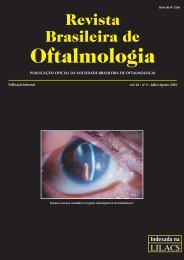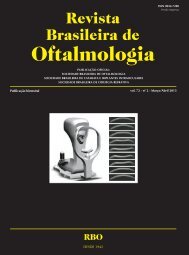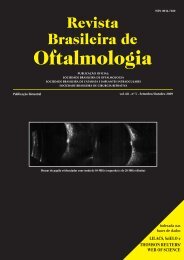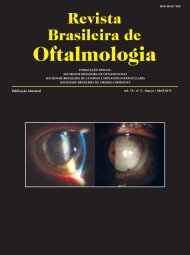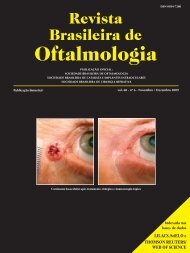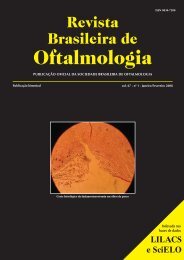Importance of genetic polymorphisms in the response to age-related macular <strong>de</strong>generation treatment195INTRODUÇÃOAge-related macular <strong>de</strong>generation (AMD) is a<strong>de</strong>generative disor<strong>de</strong>r that affects the centralretina and involves the Bruch’s membrane, theretinal pigment epithelium (RPE) and thephotoreceptors. (1,2) It is characterized by a progressive,painless loss of central vision associated with ageing.AMD is consi<strong>de</strong>red the leading cause of irreversibleblindness and responsible for a low quality of life in theaffected population. (1,3) In the United States of Americapopulation aged 40 years and ol<strong>de</strong>r, the estimatedprevalence of any AMD is 6.5%. (4) The disease is usuallyclassified into dry and wet types, responsible for 15%and 85% of cases, respectively. In the dry form, visualloss is usually gradual and is characterized by subretinal<strong>de</strong>posits called drusen or retinal pigment epithelial(RPE) abnormalities, including hyper orhypopigmentation. Larger drusen may become confluentand evolve into drusenoid RPE <strong>de</strong>tachments, which canprogress to geographic atrophy and less frequently towet AMD. Wet AMD (also called exudative orneovascular AMD) occurs when choroidal neovascularmembrane grows un<strong>de</strong>r the RPE or between the RPEand neurosensory retina, leading to subretinalhemorrhage and subsequent scar tissue formation. (1,2)Etiological research suggests that AMD is acomplex disease, caused by the actions and interactionsof multiple genes and environmental factors such assmoking and hypertension. (5,6) Recent studies have shownthat some genetic polymorphisms are associated withAMD. A genetic variation in the complement factor H(CFH) gene on chromosome 1q32 is one of the moststudied gene polymorphisms related to AMD. Thispolymorphism (rs 1061170) results in a tyrosine-tohistidinesubstitution at amino acid position 402 (Y402H)in the CFH protein. (7-33) The A69S polymorphism (rs10490924) within the gene LOC387715 on chromosome10q26 that leads to an alanine-to-serine substitution wasalso found to confer an increased risk for <strong>de</strong>velopmentof AMD. (33-50) Some papers suggested that the vascularendothelial growth factor (VEGF) gene could play a rolein the pathogenesis of AMD. (51,58) However, manydifferent single nucleoti<strong>de</strong> polymorphisms (SNPs) weretested and limited sample sizes and diverse ethnic originof cases and controls were studied to ensure a statisticallyvalid conclusion. It has also been <strong>de</strong>monstrated thatcommon CFH and LO387715 polymorphisms werein<strong>de</strong>pen<strong>de</strong>ntly related to progression from early orintermediate stages to advanced forms of the disease. (59)Herein, we review the main published studies thatevaluate the response to the treatment of AMD relatedto genetic polymorphisms.Klein et al. ma<strong>de</strong> a retrospective analysis ofparticipants of a randomized, controlled clinical trial, theAge-Related Eye Disease Study (AREDS) toinvestigate the possible association between the responseto oral antioxidants and zinc with genetic polymorphisms.The AREDS study enrolled 4757 participants from 11clinical centers and established that a combination ofzinc and antioxidants (B-carotene, vitamin C, and vitaminE) produced a 25% reduction in <strong>de</strong>velopment of AMDover 5 years and a 19% reduction in severe vision loss inindividuals <strong>de</strong>termined to be at high risk of <strong>de</strong>velopingthe advanced forms of the disease. A treatmentinteraction was observed between the CFH Y402H highriskgenotype and supplementation with antioxidants pluszinc (p = 0.03). An interaction (p = 0.004) was observedin the AREDS treatment groups taking zinc whencompared with the groups taking no zinc, but not in groupstaking antioxidants compared with those taking noantioxidants (p = 0.59). There were no significanttreatment interactions observed with LOC387715. (60)Other authors have studied the effect of theLOC387715, CFH and VEGF genotypes on the responseto photodynamic therapy (PDT) with controversialresults. (61,68) Goverdhan et al. genotyped a total of 557cases with AMD and 551 normal controls for the CFHY402H. Twenty-seven PDT-treated patients werefollowed up for 15 months and individuals with differentCFH genotypes were then analyzed for any associationwith visual change following PDT. The number of patientscarrying the high-risk C allele was 70.4% in thoserequiring PDT as compared to 52.3% in the non-PDTgroup (p=0.011), and presence of the CC genotypesignificantly increased the risk of PDT (p=0.015). The<strong>de</strong>gree of visual loss following PDT was significantlyhigher in the CFH CC genotype group (p=0.038); 50%of CC cases and 45% of the CT cases lost 15 or moreETDRS letters at final follow-up. In conclusion, theyshowed that patients homozygous for the CFH high riskallele seem to have worse outcome after PDT. (61)Brantley et al. also found a potential relationship betweenCFH genotype and response to PDT. However, theyshowed that patients with the CFH TT genotype (T: nonriskallele) fared significantly worse with PDT than thosewith the CFH TC and CC genotypes. (62) Other studies didnot show significant association between CFHpolymorphism and PDT response for neovascularAMD. (63,64) For LOC387715, two important studies haveRev Bras Oftalmol. 2012; 71 (3): 194-8
196Veloso CER, Almeida LNF, De Marco LA, Vianna RNG, Nehemy MBshown that there is no statistical significant differenceamong the genotypes in response to PDT. (62,65) However,Sakurada et al. have recently shown that there is apharmacogenetic association between the LOC387715A69S variant and the long-term results after PDT in eyeswith polypoidal choroidal vasculopathy (PCV). In thisstudy, PDT was repeated every 3 months until thedisappearance of angiographic signs of active lesions in71 eyes of 71 patients with PCV who were followed-upfor at least 12 months. There was a statistically significantdifference in the visual acuity both at the 12-month andfinal visits (p = 0.002 and P < 0.001, respectively) withthe poorer acuity in patients with the higher T-allelefrequency. (66) Immonen et al. have evaluated VEGF genepolymorphism and the outcome after PDT and showed astrong relationship between this gene and the treatmentresults. The VEGF gene polymorphic SNPs at rs699947and rs2146323 were strong <strong>de</strong>terminants of the anatomicoutcome after PDT, but the SNPs studied were notassociated with the presence of exudative AMD or withthe CNV lesion size or configuration. (67) However,Tsuchihashi et al. did not show any association betweenVEGF rs 699947 SNP and the response to PDT. (68) Othergenetic polymorphisms and its relationship with theresponse to PDT were evaluated but showed nostatistically significant results. (62,67)Recently, two studies have <strong>de</strong>monstrated theassociation between gene polymorphisms and theresponse to intravitreal injections of the antivascularendothelial growth factor (anti-VEGF) agentsbevacizumab and ranibizumab. (69,70) Brantley et al.conducted a study in which eighty-six patients withexudative AMD un<strong>de</strong>rgoing treatment with 1.25 mgintravitreal bevacizumab in one eye were enrolled.Intravitreal injections were performed at 6-weekintervals until there was no longer evi<strong>de</strong>nce of activeneovascularization. Each patient was followed for aminimum of 6 months. The authors showed that postbevacizumabVA was significantly worse in the CFH CCgenotype than for the CFH TC or TT genotypes (p=0.016).However, there was no significant difference in responseto this drug according to the LOC387715 genotypes. (69)The other pharmacogenetic study published three yearslater was conducted to <strong>de</strong>termine whether CFHgenotypes had an effect on the treatment of exudativeAMD with ranibizumab. A total of 178 patients werestudied and, for each patient, an intravitreal injection of0.5 mg of ranibizumab was performed at the initialpresentation of an active choroidal neovascular complex.Subsequent injections were performed as nee<strong>de</strong>d andpatients were followed for a minimum of 9 months. Inthis retrospective study, Lee et al. found no difference inVA outcomes after ranibizumab treatment among thedifferent CFH genotypes, in contrast to the previous studywith bevacizumab. Nevertheless, over 9 months, patientswith both risk alleles received approximately 1 moreintravitreal injection. (70)There is only one study with a large number ofpatients that addresses the preventive treatment of dryAMD related to the genetic polymorphisms. As we canobserve, the majority of published articles about thetherapeutic response of exudative AMD are related thephotodynamic therapy and many of them arecontroversial. Only two papers consi<strong>de</strong>r the intravitrealresponse to anti-VEGF agents according to the geneticpolymorphisms. Since antiangiogenic therapy is nowconsi<strong>de</strong>red the gold standard treatment of exudative AMD,there is a long way to be traversed until treatment couldbe indicated according to the genetic profile of the patient.Additional studies with a larger number of patients, longerfollow-up period and including more SNPs are importantto establish a <strong>de</strong>finite correlation between genepolymorphism and the therapeutic response in AMD. Onlythen may the treatment of this disease be recommen<strong>de</strong>dor modified based on genetic findings.REFERÊNCIAS1. Seddon JM, Chen CA. Epi<strong>de</strong>miology of age-related macular<strong>de</strong>generation. In: Ryan SJ. Retina. 4th ed. Phila<strong>de</strong>lphia:Elsevier; 2006.2. Donoso LA, Kim D, Frost A, Callahan A, Hageman G. Therole of inflammation in the pathogenesis of age-related macular<strong>de</strong>generation. Surv Ophthalmol. 2006;51(2):137-52. Commentin: Surv Ophthalmol. 2006;51(5):532; author reply 532.3. Brown G, Brown MM. Let us wake the nation on the treatmentfor age-related macular <strong>de</strong>generation. Curr OpinOphthalmol. 2010;21(3):169-71.4. Klein R, Chou CF, Klein BE, Zhang X, Meuer SM, SaaddineJB. Prevalence of age-related macular <strong>de</strong>generation in theUS population. Arch Ophthalmol. 2011;129(1):75-80.5. Scholl HP, Fleckenstein M, Charbel Issa P, Keilhauer C, HolzFG, Weber BH. An update on the genetics of age-relatedmacular <strong>de</strong>generation. Mol Vis. 2007;13:196-205. Review.6. Klein R, Cruickshanks KJ, Nash SD, Krantz EM, Javier NietoF, Huang GH, et al. The prevalence of age-related macular<strong>de</strong>generation and associated risk factors. Arch Ophthalmol.2010;128(6):750-8.7. Edwards AO, Ritter R 3rd, Abel KJ, Manning A, PanhuysenC, Farrer LA. Complement factor H polymorphism and agerelatedmacular <strong>de</strong>generation. Science. 2005;308(5720):421-4. Comment in: Science. 2005;308(5720):362-4.8. Haines JL, Hauser MA, Schmidt S, Scott WK, Olson LM, Gallins P,et al. Complement factor H variant increases the risk of agerelatedmacular <strong>de</strong>generation. Science. 2005;308(5720):419-21.Comment in: Science. 2005;308(5720):362-4.9. Klein RJ, Zeiss C, Chew EY, Tsai JY, Sackler RS, Haynes C,et al. Complement factor H polymorphism in age-relatedmacular <strong>de</strong>generation. Science. 2005;308(5720):385-9. Commentin: Science. 2005;308(5720):362-4.Rev Bras Oftalmol. 2012; 71 (3): 194-8
- Page 1 and 2:
vol. 71 - nº 3 - Maio/Junho 2012RB
- Page 3 and 4: 144Revista Brasileira de Oftalmolog
- Page 5 and 6: 146173 Características e deficiên
- Page 7 and 8: 148Rezende F, Bisol RAR, Tiago Biso
- Page 9 and 10: 150Ventura BV, Ventura M, Lira W, V
- Page 11 and 12: 152Ventura BV, Ventura M, Lira W, V
- Page 13 and 14: 154Ventura BV, Ventura M, Lira W, V
- Page 15 and 16: 156Moura EM, Volpini M, Moura GAGIN
- Page 17 and 18: 158Moura EM, Volpini M, Moura GAGco
- Page 19 and 20: 160ARTIGO ORIGINALEficácia da comb
- Page 21 and 22: 162Almodin J, Buhler Junior C, Almo
- Page 23 and 24: 164ARTIGO ORIGINALHipermetropia ap
- Page 25 and 26: 166Ambrósio Jr R, Silva RS; Lopes
- Page 27 and 28: 168Ambrósio Jr R, Silva RS; Lopes
- Page 29 and 30: 170Ambrósio Jr R, Silva RS; Lopes
- Page 31 and 32: 172Ambrósio Jr R, Silva RS; Lopes
- Page 33 and 34: 174Ventura CVOC, Gomes MLS, Ventura
- Page 35 and 36: 176Ventura CVOC, Gomes MLS, Ventura
- Page 37 and 38: 178Ventura CVOC, Gomes MLS, Ventura
- Page 39 and 40: 180ARTIGO ORIGINALPeriocular basal
- Page 41 and 42: 182Macedo EMS, Carneiro RC, Carrico
- Page 43 and 44: 184RELATO DE CASODiplopia após inj
- Page 45 and 46: 186Rassi MMO, Santos LHBTABELA 1Per
- Page 47 and 48: 188RELATO DE CASOSíndrome de Down:
- Page 49 and 50: 190Lorena SHTachados de blefarite e
- Page 51 and 52: 192Passos AF, Borges DFINTRODUÇÃO
- Page 53: 194ARTIGO DE REVISÃOImportance of
- Page 57 and 58: 198Veloso CER, Almeida LNF, De Marc
- Page 59 and 60: 200Schellini SA, Sousa RLFINTRODUÇ
- Page 61 and 62: 202Schellini SA, Sousa RLFduzidos m
- Page 63 and 64: 204Schellini SA, Sousa RLF18. Ferra
- Page 65 and 66: 206Instruções aos autoresA Revist
- Page 67: 208RevistaBrasileira deOftalmologia



